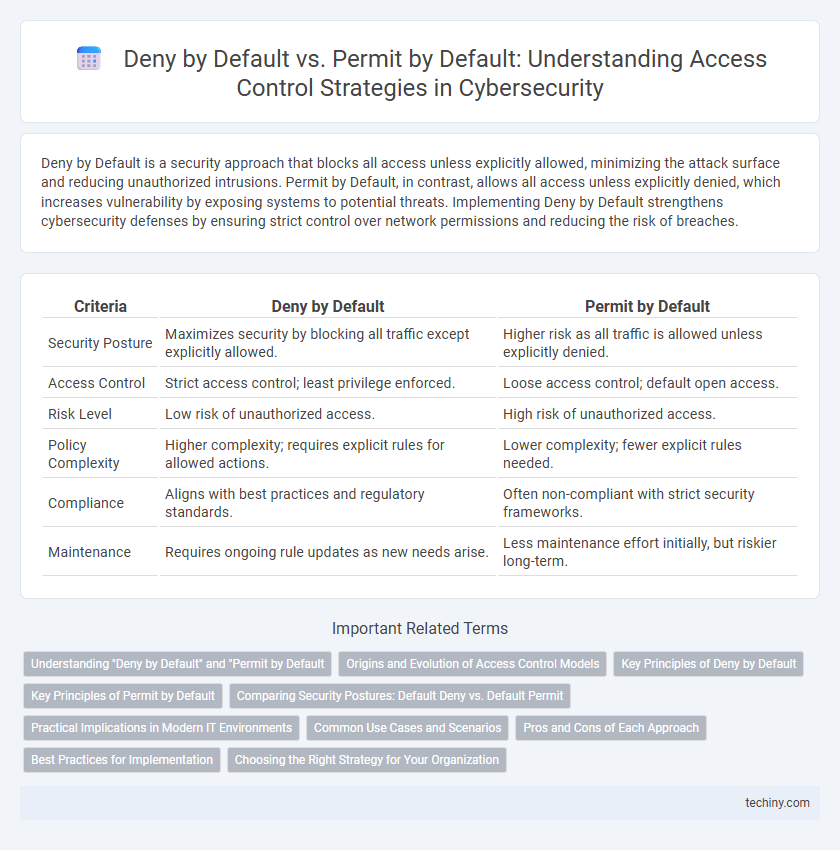Deny by Default is a security approach that blocks all access unless explicitly allowed, minimizing the attack surface and reducing unauthorized intrusions. Permit by Default, in contrast, allows all access unless explicitly denied, which increases vulnerability by exposing systems to potential threats. Implementing Deny by Default strengthens cybersecurity defenses by ensuring strict control over network permissions and reducing the risk of breaches.
Table of Comparison
| Criteria | Deny by Default | Permit by Default |
|---|---|---|
| Security Posture | Maximizes security by blocking all traffic except explicitly allowed. | Higher risk as all traffic is allowed unless explicitly denied. |
| Access Control | Strict access control; least privilege enforced. | Loose access control; default open access. |
| Risk Level | Low risk of unauthorized access. | High risk of unauthorized access. |
| Policy Complexity | Higher complexity; requires explicit rules for allowed actions. | Lower complexity; fewer explicit rules needed. |
| Compliance | Aligns with best practices and regulatory standards. | Often non-compliant with strict security frameworks. |
| Maintenance | Requires ongoing rule updates as new needs arise. | Less maintenance effort initially, but riskier long-term. |
Understanding "Deny by Default" and "Permit by Default
Deny by Default" means all access requests are blocked unless explicitly allowed, enhancing security by minimizing exposure to unauthorized actions. "Permit by Default" allows all access unless explicitly denied, which can increase convenience but raises the risk of unauthorized access if policies are not meticulously managed. Understanding these models is crucial for designing effective cybersecurity policies that balance accessibility and protection.
Origins and Evolution of Access Control Models
Deny by Default and Permit by Default access control models originated from early computer security principles aimed at managing system resource access. Deny by Default evolved from the principle of least privilege, ensuring all access is denied unless explicitly allowed, minimizing attack surfaces and unauthorized use. Permit by Default originated from legacy systems where access was generally allowed unless specifically denied, reflecting earlier, less mature security postures that have been largely replaced by more secure modern frameworks.
Key Principles of Deny by Default
Deny by Default enforces strict access control by blocking all traffic except explicitly permitted requests, minimizing security risks from unauthorized access. This principle ensures that only verified users and trusted applications can interact with critical systems, reducing attack surfaces significantly. By adopting Deny by Default, organizations implement proactive threat mitigation and maintain robust audit trails for compliance and incident response.
Key Principles of Permit by Default
Permit by Default operates on the principle that all network traffic is allowed unless explicitly denied, streamlining access management but increasing potential exposure to threats. Key principles include minimal initial restrictions, explicit denial rules to block unsafe or unauthorized actions, and continuous monitoring to detect and respond to suspicious behavior. This approach contrasts with Deny by Default by prioritizing accessibility and requiring vigilant security policies to manage risk effectively.
Comparing Security Postures: Default Deny vs. Default Permit
Default Deny enforces strict access control by blocking all traffic unless explicitly allowed, significantly reducing the attack surface and preventing unauthorized access. Default Permit allows all traffic except what is explicitly denied, increasing the risk of exposure to unknown threats and misconfigurations. Cybersecurity frameworks recommend Default Deny for enhanced protection, ensuring only vetted connections and services are permitted, thereby strengthening overall security posture.
Practical Implications in Modern IT Environments
Deny by Default enforces strict access controls by blocking all traffic unless explicitly allowed, significantly reducing attack surfaces in modern IT environments. Permit by Default allows all traffic except what is explicitly denied, increasing risk exposure but simplifying initial configuration for dynamic or legacy systems. Practical implementations often favor Deny by Default for enhanced security compliance, especially in zero-trust architectures and cloud-native infrastructures where granular policy enforcement is critical.
Common Use Cases and Scenarios
Deny by Default is commonly used in high-security environments like government networks and financial institutions where strict access control is crucial. Permit by Default is often applied in less sensitive networks or internal corporate systems to facilitate ease of access and operational efficiency. Enterprises frequently adopt Deny by Default for firewall rules and zero-trust architectures to minimize attack surfaces and enforce least privilege policies.
Pros and Cons of Each Approach
Deny by Default enhances security by blocking all traffic unless explicitly allowed, minimizing unauthorized access and reducing attack surface, but it can increase administrative overhead and risk of legitimate service interruptions. Permit by Default simplifies network access by allowing all traffic unless explicitly denied, facilitating ease of use and quicker deployment, though it exposes systems to higher risk of unauthorized activities and potential breaches. Organizations must balance strict access control and operational flexibility when choosing between these firewall policies for effective cybersecurity management.
Best Practices for Implementation
Implementing Deny by Default ensures that only explicitly authorized traffic and actions are allowed, reducing the attack surface by blocking all unknown or potentially harmful connections. Permit by Default can lead to increased vulnerabilities as it allows all traffic unless specifically denied, making it crucial to maintain comprehensive and regularly updated allow lists. Best practices recommend adopting Deny by Default combined with granular access controls, continuous monitoring, and automated rule updates to enhance overall security posture.
Choosing the Right Strategy for Your Organization
Deny by Default enforces a strict security posture by blocking all traffic except explicitly permitted, minimizing exposure to unauthorized access and cyber threats. Permit by Default allows all traffic unless explicitly denied, offering ease of use but increasing vulnerability risks due to potential overlooked threats. Organizations should evaluate regulatory requirements, risk tolerance, and operational complexity to determine the optimal balance between security and accessibility.
Deny by Default vs Permit by Default Infographic

 techiny.com
techiny.com